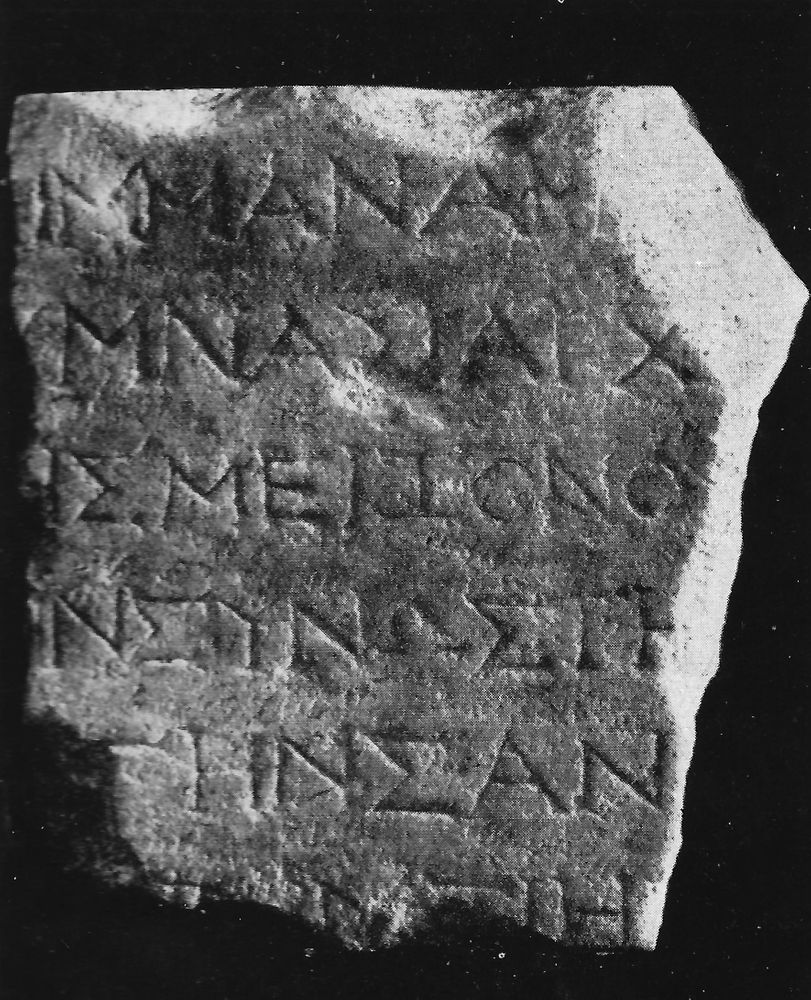EpiDoc XML:
IGCyr0653002
Trismegistos ID:
6190
Source description
Support: Fragment of marble panel broken on all sides except on top (w: 0.13 × h: 0.145 × d: 0.045).
Layout: Inscribed on the face.
Letters: Height unknown. Small omega, sigma with parallel outer bars.
Date: Second half of second century or beginning of first BC (lettering).
Findspot: Found before 1937 at Cyrene ➚(see commentary).
Place of origin: Findspot.
Last recorded location: Not found by IGCyr team.
Text constituted from: Transcription from previous editor.
Bibliography
Pugliese Carratelli – Oliverio 1961, p. 17, n. 4, fig. 10 (from †Oliverio's papers), whence SEG, 20.738; IGCyr 065300 ➚.
Cf. Robert, BE, 1964.571. Luni 1976, p. 240, n. 6; Rosamilia 2023, p. 109.
Text
Apparatus
2: [γ]υμνασιαρχ[ήσαντα] Pugliese Carratelli – Oliverio 1961
3: [.]η̣ς: [τ]ῆς Pugliese Carratelli – Oliverio 1961
6: Ἑ̣ρ̣με̣ῖ Ἡρ̣[ακλεῑ] Robert, BE: ΕΡΜΕΙΗ+ Pugliese Carratelli – Oliverio 1961
French translation
Arimmas fils d'Ari[---] gymnasiarque [---], plus grand(e) [---] à Hermès, à Héraclès.
English translation
Arimmas son of Ari[---] gymnasiarch [---] bigger [---] to Hermes, to Heracles.
Italian translation
Arimmas figlio di Ari[---] ginnasiarco [---], più grande [---] a Hermes, a Eracle.
Arabic translation
أريماس بن آري [---] جمنازيارخ (مشرف بالجمنازيوم) [---] أكبر [---] لهيرميس ، لهيراكليس.
Commentary
This fragmentary inscription is very obscure.
At line 2, we may have a form either of γυμνασίαρχος or of γυμνασιαρχέω applying either to Ἀρίμμας, who was honoured, or to the honorand(s) mentioned as subject. The syntactic analysis is the more obscure because Ἀρίμμαν, normally an accusative, may be sometimes taken as a nominative case.
Pugliese Carratelli in editio princeps suggested that this man might be the same as the priest Arimman son of Arimman mentioned in IRCyr2020 C.259, but too many personal names beginning with Ari- are attested in Cyrenaica to allow such a restoration. Rosamilia 2023 is not opposed to the identification, as the lettering does not seem to him an obstacle.
At line 3, μείζονος might be either the comparative adjective or a personal name (father's name of [---]ης).
At line 4, this strange segment allows no direct interpretation. Very tentatively, one might think of a compound of σύν with some form derived from the root of ὠθέω, 'to push'.
At line 5, the photograph has clearly as first letter a gamma, so that it is impossible to get a feminine article. Amongst the rare words beginning with σαν- there is the word σανίς which means 'tablet' and sometimes 'painted panel', but this should not be pushed ahead.
At line 6 Robert's clever reading was probably already intended by Oliverio, but Pugliese Carratelli astonishingly did not write it down. Although spelled in koine, this mention recalls the lists of ephebes ending with a dedication to Hermes and Heracles, deities of the gymnasium. However, the koine touch is also perceivable through two possible feminine articles at ll. 3 and 4, but the rest escapes analysis.
Luni thought that this might be the fragmentary list of ephebes, the discovery of which had occurred in 1936 in what has been hypothetically the Roman gymnasium (later House of Jason Magnus). However this inscription can hardly be described as a list of ephebes, whereas other fragmentary lists might perhaps be the one in question.
CC BY-NC-SA 4.0 Deed Attribution-NonCommercial-ShareAlike 4.0 International License.
All citation, reuse or distribution of this work must contain a link back to DOI: https://doi.org/10.60760/unibo/igcyrgvcyr2 and the filename (IGCyr000000 or GVCyr000), as well as the year of consultation.

